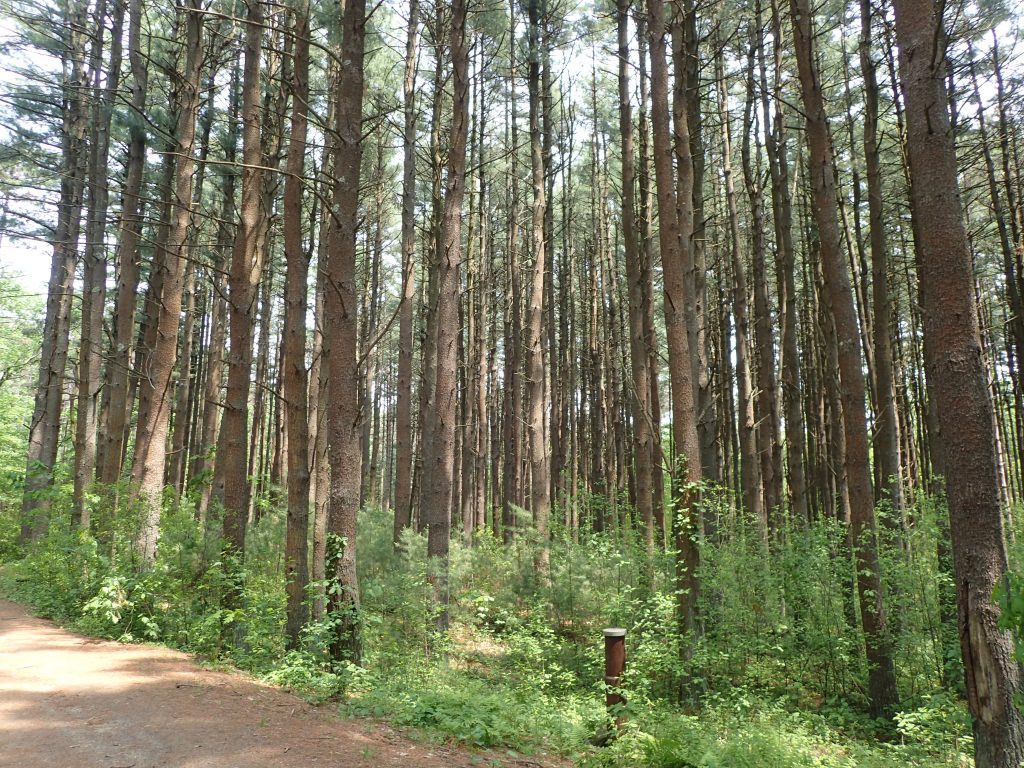
Area of high density of trees in one area of the Reading Town Forest
Reading is under consideration to host the 2020 Town Forest Conference as part of the 90th-anniversary celebration of the Reading Town Forest. The Massachusetts Department of Conservation and Recreation (DCR) organizes annual Town Forest Conferences in different towns each year to celebrate the importance of Town Forests to their communities. These conferences allow communities to learn about their forests and how to protect them.
Several members of the Reading Town Forest Committee recently attended this year’s Town Forest Conference held in Sherborn. Participants from across the state learned about forest plants and wildlife, forest management and had the opportunity to consult with experts in the field of forestry. The Sherborn conference included a site visit of their town forest. Sherborn is facing some of the same challenges in forest management that Reading is facing including plantations of red pines that were planted too close together and are suffering from die-off. Sherborn will soon remove a section of red pines and is working to control invasive plant species.
Areas of the Reading Town Forest were planted as pine plantation. This can be seen by the closely spaced rows of pine trees. Trees were periodically harvested for many years, but have not been cut for the past few decades. The result is that areas of the Town Forest are a monoculture of aging trees that were planted so close together that not enough sunlight reaches the forest floor to support sapling growth. Many trees have lost their pine needles except at the crown. A number of dead trees in the Council Ring have been marked for removal.
Ten years ago Reading had a Forest Management Plan prepared. This plan recommended selective thinning of trees to allow light to reach the ground. This will allow saplings to grow which will diversify the ages of trees. An “all-ages” forest with a range of tree sizes is healthier than a monoculture of trees of similar ages. This tree size diversity provides better habitat for birds and animals and is better able to withstand natural disaster such as fire, hurricanes, and disease.
Philip Benjamin, a Certified Forester, has been working with the Town Forest Committee since the Forest Management Plan was prepared in 2010. Mr. Benjamin has recommended a pilot program to selectively thin a limited area in the Town Forest to improve the biodiversity and overall health of the Town Forest and the dependent ecosystems. Plans are also being developed to control invasive species such as buckthorn that are crowding out native plant species. The Town Forest Committee, Department of Public Works and others plan to hold a public meeting this fall to present the proposed pilot thinning project and to update the community on the importance of improving the health of the Reading Town Forest.
The Town Forest was created in 1930. The statement made by the Town Forest Committee about the Council Ring at the April 26, 1930, Town Forest Dedication Day was:
“The circle will represent cooperation. As the trees mature here will be an ideal spot for scouts and other groups to gather inside a circle of towering pines and realize that the citizens of Reading in the year 1930 – Tercentenary Year – planted a forest primeval that a coming generation might enjoy to the full, God’s great out-of-doors and reap the benefits that patience and care alone can bring.”
It is important that the health of the Reading Town Forest be improved so that the vision of those who created the forest can be maintained long after the 90th-anniversary celebration.
